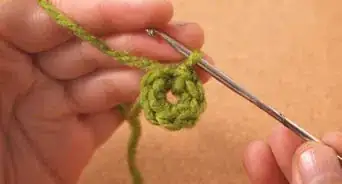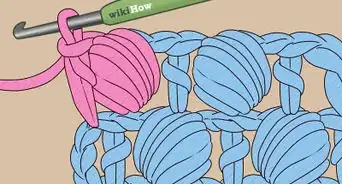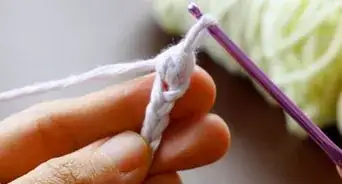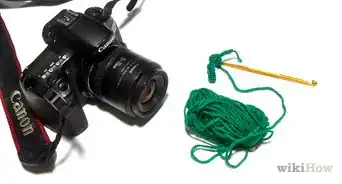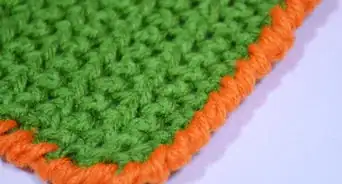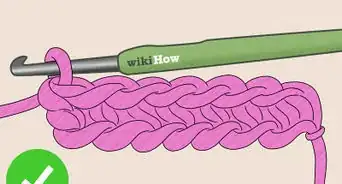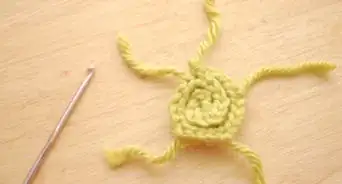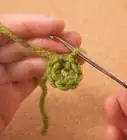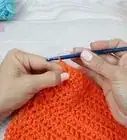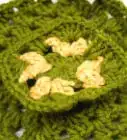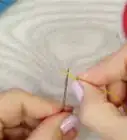This article was co-authored by Sarah Stearns. Sarah Stearns is a DIY Specialist, Artist, Maker, Blogger, and the Founder of SarahMaker.com. With over ten years of experience, she specializes in fun, approachable crafts like crocheting, making polymer clay jewelry, quilting, and creating Cricut projects. Her work has been featured in several publications, such as Scientific American, Good Housekeeping, Vox, and Apartment Therapy. Sarah holds a BA in Psychology from Vanderbilt University.
This article has been viewed 167,496 times.
Looking to spice up your next craft project? You're in luck. Triangle stitches can be used to create a triangle pattern throughout a larger work, or to create individual triangles using both row and round methods. And we're going to walk you through everything you need to know. Read on for more!
Steps
Triangle Stitch[1]
-
1Create a foundation chain. You will need to work chain stitches in multiples of three, then add one to complete the chain. For instance, your foundation chain could consist of 19 (18 + 1), 22 (21 + 1), or 31 (30 + 1) chain stitches.
- To make a slip knot:
- Cross the attached end of the yarn over the working end to create a loop.
- Push the attached side of the yarn into this loop from underneath it, creating a second loop. Tighten the first loop to secure the second loop.
- Insert the crochet hook into the second loop and tighten it.
- To make a chain stitch:
- Wrap the attached side of the yarn in between the hook and the loop already on the hook.
- Pull this yarn through the loop on your hook to complete the stitch.
- To make a slip knot:
-
2Single crochet across the chain. Work one single crochet into the second stitch from your hook. After that, work one single crochet into each stitch of the previous row until you reach the end of the row.
- Turn the piece over when you reach the end of the row.
- If you do not know how to work a single crochet, check the “Tips” section for instructions.
Advertisement -
3Work four chain stitches. Work these stitches directly from the loop already on your hook.
- This set of chain stitches will count as both a half double crochet and an additional set of two chain stitches.
-
4Yarn over as you pick up stitches. Skip the first stitch of your previous row. Then, wrap the yarn around the hook, insert it through the next stitch (the second stitch of the previous row), and catch the yarn on the other side. Pull the yarn back through to the front of the stitch.
- Repeat this process two more times, moving onto the next stitch in the previous row each time. When finished, you should have seven loops on your hook.
- This step starts the actual triangle stitch.
-
5Draw through seven loops. Yarn over the tip of the hook again, then draw this last bit of yarn through all seven loops previously gathered onto your hook.
- When finished, you will only have one loop on your hook.
- This step completes the actual triangle stitch.
-
6Work two chain stitches. Work these chain stitches from the loop already on your hook.
- This will create a gap in between your individual triangle stitches.
-
7Make another triangle stitch. Follow the same steps indicated above to create another triangle stitch.
- Yarn over the tip of the hook, then insert the hook through the last stitch you worked your previous triangle stitch into.
- Yarn over the hook from the back and pull the yarn back to the front of the stitch.
- Yarn over the hook, insert it into the next stitch, and catch the yarn from the back before pulling it to the front. Repeat once more with the following stitch.
- Once seven loops have been gathered on your hook, yarn over the hook and pull the yarn through all seven loops.
- This series of moves completes your second triangle stitch.
-
8Repeat to the end of the row. Chain two, then repeat another triangle stitch exactly as described in the previous step. Repeat this pattern until you reach the end of the row.
-
9Work one chain stitch and one half double crochet. Chain once, then work one half double crochet into the last single crochet stitch of the previous row.
- Turn the work over at the end of this row.
- Read more about half double crochets in the “Tips” section.
-
10Chain once. Work one chain stitch off the loop on the hook to advance to the next row.
-
11Single crochet across the row. The placement of your single crochets will vary based on where they land in the row.
- Single crochet once in the first stitch.
- Single crochet once in the next "chain one" space from the previous row.
- Single crochet twice into each of the "chain two" spaces from the previous row.
- Single crochet once into the second loop of your original turning chain from the previous row.
- Turn the work when finished with this row.
-
12Repeat as needed. At this point, you should have your foundational chain, your prep row, your first row of triangle stitches, and your second "in between" row. Repeat the steps used for the triangle stitch row and the "in between" row, alternating back and forth, until your project reaches your desired length.
- Cut the yarn. Pull the tail through the loop on your hook and tighten it as much as possible to tie off the work. Weave the excess tail into the back of your work to hide it from sight.
Triangle in Rows
-
1Create a foundation chain. Work a starting chain of 13 chain stitches.
- You'll need to start your work by tying a slipknot onto the hook. If you do not know how to do this, see the "Tips" section for more detail.
- You can also check the "Tips" section for instructions on working a chain stitch.
-
2Work 12 single crochets across the chain. Skip the first stitch of your previous row, then work one single crochet into each of the remaining stitches until you reach the end of the row.
- When finished, this row should have 12 stitches.
- Check the “Tips” section for more information about working single crochets.
-
3Decrease twice in the next row. Work one single crochet decrease across the next two stitches of the previous row. Single crochet once in each of the next eight stitches, then work another one single crochet decrease into the final two stitches of the row.
- When finished, you should have 10 stitches in this row.
- If you do not know how to work a single crochet decrease, check the “Tips” section for instructions.
-
4Single crochet in each stitch. For the next row, simply work one single crochet into each stitch of the previous row.
- This row should have a total of 10 stitches.
-
5Decrease twice in the fourth row. Work one single crochet decrease into the first two stitches of the third row. Single crochet once into each of the next six stitches, then work another one single crochet decrease into the last two stitches of the row.
- There should be eight stitches in this row when you finish it.
-
6Single crochet in each stitch for the fifth row. Work one single crochet into each stitch of the fourth row to complete the fifth row.
- This row should also have 8 stitches, just like the previous row had.
-
7Repeat this pattern for another seven rows. Continue working rows with two single crochet decreases in them, separated by rows of nothing but single crochets. Repeat this for another seven rows, until you reach the twelve row.
- Row six should have six stitches (one single crochet decrease, four single crochets, and one single crochet decrease).
- Row seven should have six stitches (six single crochets).
- Row eight should have four stitches (one single crochet decrease, two single crochets, and one single crochet decrease
- Row nine should have four stitches (four single crochets).
- Row ten should have two stitches (one single crochet decrease, one single crochet, and one single crochet decrease).
- Row eleven should have two stitches (two single crochets).
- Row twelve should have one stitch (one single crochet decrease).
-
8Single crochet around the edge of the piece. The basic triangle is finished at this point. To smooth out the edges, work one single crochet into each stitch around the sides of the work and three single crochets into the gap at each point.
- Cut the yarn, leaving a 2 inch (5 cm) tail. Pull this tail through the loop on your hook and tighten it to tie off the triangle. Weave the tail into the back of the work to hide it.
Triangle in the Round
-
1Make a foundation circle. Work four chain stitches from the slipknot loop on your hook. Slip stitch the first and last stitches of this chain together to form a ring.
- Check the “Tips” section for instructions on how to make a slipknot, chain stitch, and slip stitch.
-
2Work six chain stitches. Work this secondary chain directly from the loop already on your hook.
- These six stitches will count as your first double crochet , as well as the first corner of your first triangle round.
-
3Double crochet three times. Work three double crochets into the center of your ring. Chain three times to separate this set from the next.
- Check the “Tips” section if you need further detail on working double crochets.
-
4Double crochet another three times. Work another three double crochets into the center of the ring, then chain three more times off the final double crochet in the set.
-
5Close the first round. Make two more double crochets into the center of the ring. Slip stitch final loop of the second double crochet into the third chain stitch of the six-chain series you worked when advancing to this round.
- This step completes the first triangle round. You can end the triangle here, or you can keep working additional rounds to expand it outward.
-
6Advance to the next round. Work six chain stitches off the loop on your hook.
- As before, these chains will act as the first double crochet and the first corner of this round.
-
7Work three double crochets. Work these double crochets into the first "chain three" space of your previous round. Chain once to separate this set from the next.
-
8Double crochet two sets in the next corner. In the next corner gap, double crochet three times, chain three times, and double crochet another three times. End this double set by chaining once.
-
9Double crochet around the rest of the round. You will need to repeat the previous step in the next corner space. Once you return to the first corner space, work two double crochets into the space. Use a slip stitch to join this final double crochet to the third chain of your original six-stitch chain from this round.
-
10Advance to the next round. Work six chain stitches off the loop on your hook.
- This chain serves as both the first double crochet and the first corner of your third round.
-
11Follow a similar pattern to complete this round. You will need to follow the same steps used on the previous round to complete this round. The only difference is that you will have chain spaces to work with as well as corner spaces.
- In the first corner space, work three double crochets, then chain once.
- In each corner space, double crochet three times, chain three times, then double crochet another three times. Chain one at the end of the set.
- In each non-corner gap, double crochet three times, then chain once.
- When you reach the first corner space of this round, double crochet twice into the space. Join this set with the third chain of your six-stitch chain using a slip stitch.
-
12Repeat as needed. The triangle can be used as is, but if you want to make it bigger, you only need to follow the previous step until you reach your desired size. Make sure that the final stitch you make is a slip stitch.
- Cut the yarn, leaving a 2 to 3 inch (5 to 7.6 cm) tail. To knot off the triangle, pull this tail through the loop on your hook as tight as possible. You can weave the remainder of the excess tail into the back of the triangle to hide it.
Things You'll Need
- Crochet hook
- Yarn
